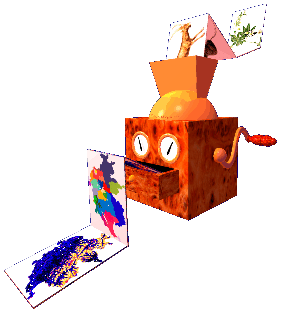
 |
|
|
Biomapper package
|
Biomapper is a kit of GIS- and statistical tools
designed to build habitat suitability (HS) models and maps. It is centred
on the Ecological Niche Factor Analysis (ENFA)
but comprises several other modules designed either to prepare the maps
before the ENFA or to process its results.
These modules work indenpendently of Biomapper and may be used for other tasks. Here is an insight of what they do. They are downloaded with Biomapper. |
|
BigGroup
|
Big Group determines contiguous groups of identically
valued integer cells in a map. Cells belonging to the same contiguous group
are given a unique integer identifier (in fact, of real type), numbered
from 1 and consecutively in the order found.
This module is similar to the Idrisi GROUP module but is more
efficient
|
|
Booleanisator
|
This module is designed to convert a quantitative or qualitative map into several boolean maps covering a given value interval. E.g., convert a digital elevation model into three boolean maps, elevation less than 500 meters, from 500 to 1000 m, 1000 m and above. |
|
CircAn
|
This contextual operator produces an image where each
cell contains a value integrating variously data lying in a surrounding
circular area. This can be viewed as a circular-moving window. The integration
consist of one of the following statistics:
- Frequency of occurrence of non-background cells
The user can change the radius of the circular window.
|
|
Convertor
|
Convertor is useful to create a map from a list of locations given by their coordinates and thematic attributes (e.g. species observation lists). |
|
DistAn
|
On the basis of a boolean map of observation
points, Distance Analysis computes some distance-related statistics used
for instance for home-range analyses. The following analyses are implemented: - Minimum distance (as crows fly) - Topographic distance (as lemmings run) - Distance harmonic mean - Distance geometric mean - Minimum convex polygon - Voronoi tesselation |
|
Grid Convertor
|
Grid Convertor allows converting ESRI grids into
Idrisi rasters, and conversely. Several files may be converted in one operation.
Remember that Biomapper use the same file format as Idrisi.
WARNING! Due to ESRI proprietary politics, GridConvertor does only work if you have ArcView with Spatial Analyst installed on your computer. (Tested with ArcView 3.0 and 3.1) |
|
GroupStat
|
Given a map with cell value representing groups (e.g.
obtained by GROUP or Big Group), an optional map containing some quantitative
values, GroupStat associates to each group a value obtained by some statistical
summarizing operation on all the cells of that group.
The Output can be in the form of a summary table or a new map where each cell takes the value of the whole group to which it belongs. The available operations are :
Area does the same operation as Idrisi AREA operator but it can
handle more categories (2'147'483'648 in place of 16'000) and can read
all three types of input map.
|
|
Map-3D
|
The purpose of Map-3D is to provide a pleasant 3-D
display of a landscape. This allows the user to better understand spatial
structures. It uses a digital elevation model (DEM) to display the landscape
from a customisable point of view, with shade induced by a parallel light.
Another Idrisi raster may be draped over the landscape, using either a
pre-existing colour palette or palette file built with Idrisi. Map-3D has
thus the same purpose as Idrisi module ORTHO but is easier and faster to
use.
The final image may be saved in BMP format. |
|
Map
Calculator
|
MapCalculator computes a new map by applying to
each cell a user-defined function of several other maps. It is similar to Idrisi's "IMAGE CALCULATOR". However, here the expression is first parsed internally and all computations made simultaneously. With complex expressions this will make the process faster and will not generate all these temporary files, which can take a lot of hard-disk space. |
|
Map Manager
|
This module allows the user to delete, rename maps and convert
data types. It is also possible to browse the metadata and to add comments
to them, as well as calling MapViewer to display the selected maps.
It is mainly useful if you don't have Idrisi. |
|
Map-Viewer
|
This module is designed to displaying maps with various palettes. It is possible to overlay two maps to compare them by transparency. It can also be used to produce WMF files that can be imported into your word processor providing map figures with scale and legend. |
|
Sampler
|
Sampler generates two boolean maps where cells are
set to “true” or “false” following a random uniform distribution. The two
maps are complementary. The user may choose the number of cells to sample
and the proportion of cells to assign to each map. The purpose is to part
a species observation map into a calibration and a validations set.
Alternatively, it is possible to generate a regular sampling design (grid). |
|
Value Extractor
|
This module extracts values from a set of maps. The output file is an ASCII file giving X and Y coordinates and cell values. It does the reverse operation of the module Convertor. It is useful to export data into a grid-based statistical software (e.g. S-plus, Systat, Excel) for further analysis (e.g. GLM or GAM) |
| Contact the webmaster |
|
Updated 27.03.2004
|